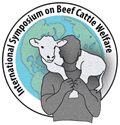Handling Cattle Loose in a Field
Expert livestock handlers stress the need to understand cattle behavior when trying to gather and move cattle loose at the scene of an accident.
MANHATTAN, Kan. (May 19, 2010) — What happens when a loaded livestock trailer is involved in a highway accident and cattle escape? All too often, the actions of people at the scene make a bad situation worse. During the Emergency Preparedness Seminar that preceded the International Symposium on Beef Cattle Well-Being, livestock handling consultants Jennifer Woods, of Blackie, Alta., and Tom Noffsinger, of Benkelman, Neb, discussed the common mistakes and offered advice for handling cattle running loose at the scene of an accident.
Addressing an audience consisting of emergency response personnel as well as cattle producers, Woods emphasized that fear is the strongest stressor animals can experience, and distressed or injured animals are unpredictable. When frightened, cattle will react instinctively. Usually, their strongest instinct is to flee. When cornered, however, they will fight.
“They do not think. They react,” Woods stated. “Cattle live in the moment. You cannot reason with them.”
According to Woods, low-stress cattle handling techniques should be used always, but such methods are critical at the scene of an accident. Flashing lights, sirens, traffic and crowds of people heighten fear in loose cattle. Common mistakes include trying to handle the cattle with too many people, too hurriedly and with too much noise. Sometimes, police or others at the scene try to chase animals with their cars. If cattle haven’t fled the scene already, Woods recommends allowing them some time to settle down.
“Don’t chase them. Give them time to chill before you do anything,” she advised, reminding the audience that cattle handle better as a group. Lone animals can be particularly dangerous. If possible, cattle should be gently gathered together on the same side of the road. Better still, they could be directed to a nearby field away from traffic and other commotion.
In an ideal world, all cattle would be trained to respond to the low-stress handling methods taught by Woods and Noffsinger. But it’s not an ideal world, and an accident involving loose cattle is far from an ideal situation.
“The scene of an accident is not a good place to train animals, but you have to try to take the animals’ focus away from the traffic, noise and confusion, and lead them to where you want them to go,” Noffsinger explained. “Try to make the animal and human interaction a positive experience for the cattle. They actually need and want someone to lead and guide them to where they feel safe.”
Noffsinger echoed Woods warning against trying to handle the cattle with too many people, especially if the people are inexperienced in handling cattle. One person who understands cattle, their herd mentality and prey animal instincts can often handle the situation better than a group of people.
According to Noffsinger, such a person avoids circling around cattle (like a stalking predator) and does not try to drive the herd from behind. A savvy handler works from near the front of a herd, approaching at an angle to initiate motion among lead animals, which will draw the remainder of the herd to follow.
Noffsinger advised handlers to establish a “working zone” by maintaining sufficient distance from the herd to achieve a desired response. Moving closer to apply pressure initiates movement, and moving farther back rewards the animals’ response. By working from the side of the herd, moving parallel to its direction of movement, a handler can control the speed of movement. Advancing in the same direction the cattle are flowing, toward the front of the herd, the handler can slow and even stop its movement. By moving toward the rear of the herd, in the opposite direction of flow, the handler can hasten movement.
“Motion is a powerful magnet that pulls the herd along. Direction and speed of motion can be controlled by the way you apply and release pressure. But cattle need to be able to see where the pressure is coming from and see a place to go, simultaneously,” Noffsinger explained. “And if they don’t go where you want them to, it’s because you didn’t ask them correctly.”
The beef cattle welfare symposium was conducted on campus at K-State University May 19-21. For additional presentation summaries, return to the Meetings > Other Industry Meetings > News Coverage page of the API Virtual Library. For more about the symposium and an archive to the 2008 symposium, visit www.isbcw.beefcattleinstitute.org.
Editor's Note: This article was written under contract or by staff of Angus Productions Inc. (API), which claims copyright to this article. It may not be published or distributed without the express permission of API. To request reprint permission and guidelines, contact Shauna Rose Hermel, editor, at 816-383-5270.

